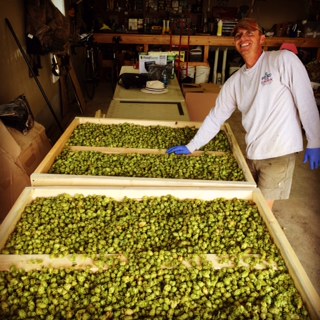Back in March we were still just planning the hop yards, and I sent some marketing feelers around to a couple of the breweries across the state. 2 Witches down in Danville was one of the earliest enthusiastic responses I received - and we kept in touch throughout the growing season.
 |
| The 3.5 barrel system at 2 Witches |
Finally, when the hops were ready, the folks down there told me they'd like five pounds of Cascade - which I gladly reserved for them while I figured out the logistics of delivery. This was a complex matter for me, for a couple of reasons, which I'll describe later in the post.
Part of what makes a small hop farm worthwhile is the relationship you get to build with the brewers who will use your hops. In the case of this brewery, I was excited because I consider Danville, way down there in Virginia along the NC border, to be home territory, since my parents were born and raised in Eden and Stoneville, less than 10 miles away. The response from the brewery was warm and welcome, so I looked forward to completing the sale, and I will make sure that everything works out satisfactorily for them.
 |
| On tap at 2 Witches |
Having been down US 29 a few times before, I was looking forward to revisiting some of the landmarks along the way - the gentle rolling hills and fields between Warrenton and Charlottesville, crossing the James River at Lynchburg, etc. I'd forgotten the distance, but that really wasn't a problem; as it turns out I was part of a mad rush until Charlottesville because of the UVA - Notre Dame game that was happening in the afternoon.
At last I arrived at the brewery. They've got a good space in an old industrial warehouse area, and they've been able to improve it with some outdoor areas on the old loading docks and a new garden. In fact, the brewery is also a winery, so there were a couple of rows of vines planted on the grounds.
While ordering a flight, I talked for a bit with Alex, the brewer, while we completed our business. The name of the brewery originates with a family photo of two very cute young girls in witches costumes. Those women are now part of the business, working on the winery side.
I mentioned my family connection and we discussed the Miller Coors brewery in Eden. Alex is taking brewing classes there, so he was familiar with the town. He's heard rumors that a nano will be starting up downtown there soon - something to look forward to on future visits.
 |
| The flight I enjoyed at 2 Witches. |
I mentioned the logistics challenges on this delivery - so as a wrap up I'll write about that. When I received my lab results from Virginia Tech, they advised that I move anything that didn't sell quickly into the freezer, so I did just that after a week. I had about 12 pounds left at the time, and that's what I froze - subsequently delivering a two pound order to Tin Cannon, and a five pound order to Hopkins Ordinary, keeping the hops frozen during transport and until delivery.
Knowing the distance to Danville, my first thought was to figure out how to ship them, but I decided the risk to quality from a thaw cycle while they were en route was not acceptable. I decided I would drive down with them - I could ensure they were in good condition and have an enjoyable time visiting the brewery as well.
I also enjoyed a flight of the on tap offerings while I was at 2 Witches. There was a good range and balance with a couple of wheats, a brown, and two pale ales on tap. Alex told me that they will use the hops I delivered to dry hop an ale that's currently in primary - you know, that's something we can be proud of!



















































